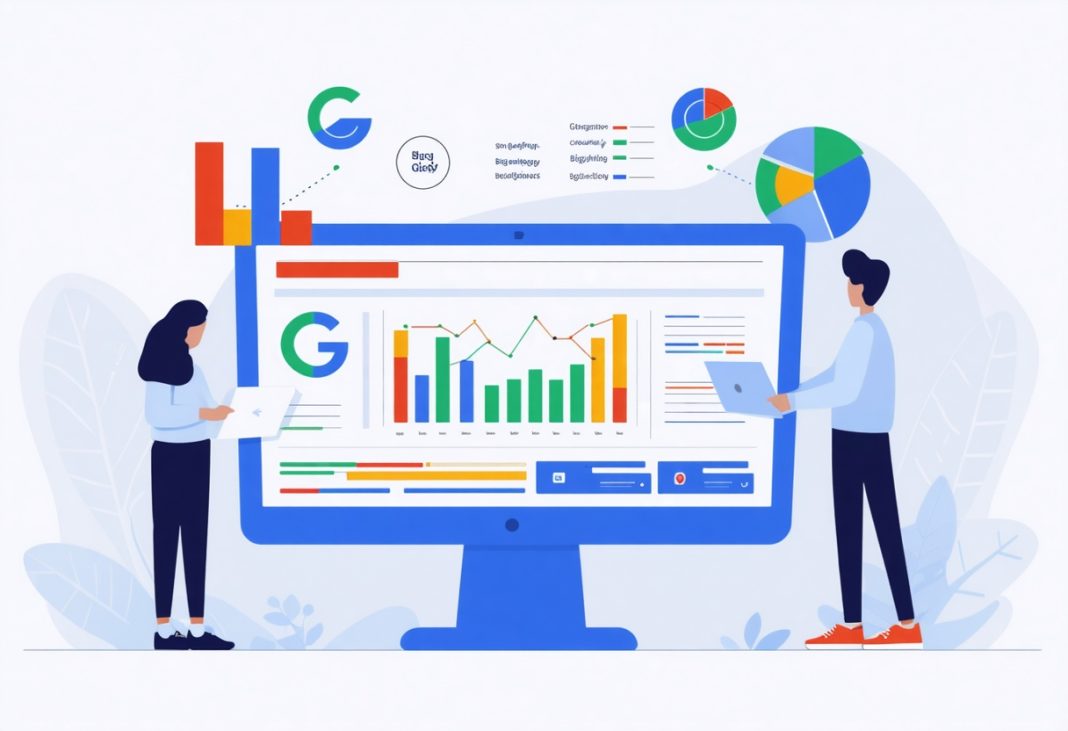To maximize efficiency with Google BigQuery, businesses should optimize query performance by using tools like Cloud Monitoring and BigQuery BI Engine, and manage costs effectively with BigQuery’s on-demand and capacity-based pricing models. Additionally, adopting best practices for efficient queries, such as minimizing data processed and optimizing join patterns, further enhances performance and reduces expenditures.
Introduction to Google BigQuery and Its Impact on Analytics
Google BigQuery is a fully-managed enterprise data warehouse that excels in handling extensive data analysis efficiently and cost-effectively. It stands out for its scalability and ease of use, enabling businesses to focus on deriving insights rather than managing infrastructure.
Key features of Google BigQuery include:
- Integration with Google Analytics: Allows real-time access to large datasets, enhancing data analysis capabilities.
- Support for various data sources: Includes CRM systems, commerce platforms, and social media like Google Ads and Facebook, enabling comprehensive business insights.
- Advanced analytics: BigQuery supports ad hoc analysis, machine learning, and business intelligence through seamless SQL integration.
The introduction of the data insights feature in BigQuery, part of the Gemini project, marks a significant advancement. This feature:
- Addresses the ‘cold-start’ problem: Helps analysts understand new datasets faster by suggesting relevant queries based on metadata.
- Automates query generation: Enhances efficiency by using metadata to suggest valuable data explorations, thus saving time and resources.
BigQuery’s cost-effectiveness is notable, with most organizations spending less than $100 per month. This affordability is due to its serverless nature, meaning charges are based only on the storage and processing services used.
Overall, Google BigQuery provides robust tools and capabilities that make it a powerful asset for any organization aiming to leverage data for strategic decisions.

Case Studies: How Global Companies Use BigQuery
- Google BigQuery offers scalable solutions for companies of all sizes across various industries. From e-commerce to international logistics, businesses use BigQuery for its flexibility and cost-effectiveness in data-driven decision-making.
- A case study highlighted a company reducing its BigQuery costs by over 70%. By optimizing data processes and using selective fields and partitioned tables, they achieved a 38.91% cost reduction in just 20 days, eventually saving 77.23% after a month.
- Data modeling in BigQuery involves choosing between normalized, denormalized, and nested schema designs. Each design impacts storage and compute efficiency differently:
- Nested schemas are space-efficient and allow for data compression.
- Normalized schemas eliminate redundancy but require more columns for primary keys.
- Denormalized schemas are less space-efficient due to data repetition.
- It’s crucial for companies to blend different schema designs to optimize BigQuery usage, balancing storage and compute resources effectively. This approach helps in managing costs and enhancing performance.
Technical Deep Dive: Optimizing Queries and Managing Data in BigQuery
When working with Google BigQuery, improving query performance and managing data efficiently are key. Here are some technical strategies to enhance your experience:
- Query Performance Optimization:
- Use Cloud Monitoring or BigQuery administrative resource charts to evaluate query performance.
- Deploy BigQuery BI Engine to speed up SQL queries by caching frequently accessed data.
- Focus on optimizing significant workloads in your data analytics pipelines to achieve the best performance.
- Cost Management with Pricing Models:
- BigQuery offers on-demand and capacity-based pricing models.
- The on-demand model charges based on the data each query processes.
- The capacity-based model allows for a consistent monthly budget and provides more capacity, measured in slots, which enhances the performance of complex queries and high concurrency workloads.
- Query Plan Analysis:
- Understanding the query plan for each execution is vital. It shows execution statistics and stages.
- Use BigQuery Visualiser to graphically understand the execution stages and identify resource-intensive areas.
- Best Practices for Efficient Queries:
- Minimize the data processed by avoiding “SELECT *”, using excessive wildcard tables, and oversharding.
- Optimize queries by pruning partitioned queries, reducing data before joins, and strategically using WHERE clauses.
- Improve query structure by avoiding repetitive data transformations, optimizing join patterns, and breaking complex queries into smaller segments.
- Use INT64 data types for joins and materialize large result sets to enhance performance.
- Avoid anti-SQL patterns like self joins, cross joins, and DML statements for single row updates or inserts.
These practices and tools help maximize efficiency when managing and querying large datasets in BigQuery.

The Future of Data Analytics with BigQuery
- Google Cloud is transforming business practices by merging BigQuery, Vertex AI, and Gemini. This combination allows organizations to use AI within secure data settings, streamlining operations and automating repetitive tasks.
- Google’s focus on accessibility and scalability in its data analytics tools like BigQuery is paving the way for a more inclusive future in the tech industry. This approach aims to attract diverse talent, essential for innovation and tackling complex issues.
- Recent updates to BigQuery have enhanced its AI capabilities, integrating with Gemini via Vertex AI for advanced data analysis. Industries such as healthcare and retail benefit from these improvements by gaining insights from large-scale, diverse data sets.
- BigQuery now supports Gemini 1.0 Pro through Vertex AI, improving data handling and quality of outcomes in tasks like text summarization and sentiment analysis. This integration allows the creation of sophisticated data pipelines that combine different types of data.
- Google is also expanding the capabilities of BigLake to extract more value from unstructured data. By using Vertex AI’s APIs, users can now analyze documents and audio files more effectively.
- The introduction of vector search in BigQuery, integrated with Vertex AI, opens up new possibilities for semantic search and data retrieval applications.
- Looking ahead, Google plans to continue enhancing BigQuery with more AI-driven features. These advancements will simplify building analytics applications, making them faster and more secure.
For more on how DataLemon can help integrate these technologies into your business, visit our Google Analytics Audit and Tag Manager Audit services.

FAQ
What is Google BigQuery and why is it significant in analytics?
Google BigQuery is a fully-managed enterprise data warehouse designed to process large-scale data efficiently and cost-effectively. Its significance lies in its ability to handle extensive data analysis with ease due to its scalability and ease of use, allowing organizations to focus on deriving insights rather than managing infrastructure.
How does Google BigQuery integrate with other data sources?
BigQuery supports integration with various data sources including CRM systems, commerce platforms, and social media like Google Ads and Facebook. This wide-ranging support enables comprehensive business insights by allowing real-time access to large datasets.
What are the cost implications of using Google BigQuery?
BigQuery is cost-effective, with most organizations spending less than $100 per month. This affordability is primarily due to its serverless nature, where charges are based only on the storage and processing services used, not on standing infrastructure.
Can you describe the different data schema designs in BigQuery and their impact?
Data modeling in BigQuery can involve choosing between normalized, denormalized, and nested schema designs. Nested schemas are more space-efficient and allow for data compression, normalized schemas remove redundancy but require more columns for primary keys, while denormalized schemas are less efficient due to data repetition. The choice of schema design affects both storage and compute efficiency.
What techniques can be used to optimize query performance in BigQuery?
Optimizing query performance in BigQuery can be achieved by using Cloud Monitoring to evaluate performance, deploying the BigQuery BI Engine for faster SQL queries, and focusing on optimizing significant workloads. Additionally, minimizing data processed, pruning partitioned queries, and optimizing join patterns are effective strategies.
How does Google BigData handle pricing models?
BigQuery offers two pricing models: on-demand and capacity-based. The on-demand model calculates costs based on the data each query processes, while the capacity-based model provides a consistent monthly budget and enhances performance through more capacity for complex queries and high concurrency workloads.
What future advancements in BigQuery are anticipated?
Future enhancements for BigQuery involve further integration with AI tools like Vertex AI and Gemini, improving capabilities such as text summarization and sentiment analysis. Additionally, the expansion of BigLake and new features like vector search aim to provide more profound insights from diverse and unstructured datasets.
How do companies typically reduce their BigQuery costs?
Companies can reduce BigQuery costs effectively by optimizing data processes, using selective fields, implementing partitioned tables, and blending different schema designs to balance storage and compute resources efficiently. A documented case showed a company reducing BigQuery costs by over 70% by applying these strategies.




